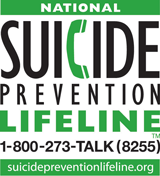Suicide: Risk and Protective Factors
On This Page
Risk Factors for Suicide
A combination of individual, relationship, community, and societal factors contribute to the risk of suicide. Risk factors are those characteristics associated with suicide—they might not be direct causes.
Risk Factors
- Family history of suicide
- Family history of child maltreatment
- Previous suicide attempt(s)
- History of mental disorders, particularly clinical depression
- History of alcohol and substance abuse
- Feelings of hopelessness
- Impulsive or aggressive tendencies
- Cultural and religious beliefs (e.g., belief that suicide is noble resolution of a personal dilemma)
- Local epidemics of suicide
- Isolation, a feeling of being cut off from other people
- Barriers to accessing mental health treatment
- Loss (relational, social, work, or financial)
- Physical illness
- Easy access to lethal methods
- Unwillingness to seek help because of the stigma attached to mental health and substance abuse disorders or to suicidal thoughts
Protective Factors for Suicide
Protective factors buffer individuals from suicidal thoughts and behavior. To date, protective factors have not been studied as extensively or rigorously as risk factors. Identifying and understanding protective factors are, however, equally as important as researching risk factors.
Protective Factors
- Effective clinical care for mental, physical, and substance abuse disorders
- Easy access to a variety of clinical interventions and support for help seeking
- Family and community support (connectedness)
- Support from ongoing medical and mental health care relationships
- Skills in problem solving, conflict resolution, and nonviolent ways of handling disputes
- Cultural and religious beliefs that discourage suicide and support instincts for self-preservation
(U.S. Public Health Service 1999)
Additional Resources
- DeLeo D, Bertolote J, Lester, D. Self-directed violence. 2002. Chapter 7. In: Krug EG., Dahlberg LL., Mercy JA, Zwi A, Lozano R, eds. World report on violence and health [PDF 239 KB]. Geneva: World Health Organization.
- Goldsmith SK, Pellmar TC, Kleinman AM, Bunney WE, eds. Reducing suicide: a national imperative. Washington DC: National Academy Press; 2002.
- McLean, J, Maxwell, M, Platt, S, Harris, F, and Jepson, R. Risk and Protective Factors for Suicide and Suicidal Behaviour: a Literature Review. Scottish Government Social Research. Edinborough. 2008.
- U.S. Department of Health and Human Services (HHS) Office of the Surgeon General and National Action Alliance for Suicide Prevention. National Strategy for Suicide Prevention: Goals and Objectives for Action. Washington DC: HHS; 2012.
- U.S. Public Health Service. The surgeon general’s call to action to prevent suicide. Washington DC: US Department of Health and Human Services; 1999.
- World Health Organization. Preventing suicide: A global imperative. Geneva, Switzerland: WHO; 2014.
Need Help? Know Someone Who Does?

Contact the National Suicide Prevention Lifeline
- Call 1-800-273-TALK (1-800-273-8255)
- Use the online Lifeline Crisis Chat.
Both are free and confidential. You’ll be connected to a skilled, trained counselor in your area.
For more information, visit the National Suicide Prevention Lifeline.
- Page last reviewed: October 3, 2017
- Page last updated: October 3, 2017
- Content source:


 ShareCompartir
ShareCompartir
